Samsung Galaxy S20 Ultra (Snapdragon 865) Quick Performance Preview: Impressive
by Andrei Frumusanu on March 13, 2020 6:00 AM EST- Posted in
- Mobile
- Samsung
- Smartphones
- Galaxy S20
- Galaxy S20 Ultra
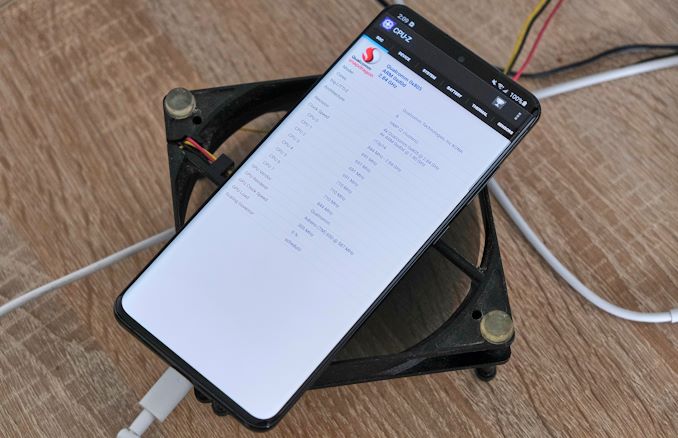
Samsung's Galaxy S20 series phones have been available since last Friday in markets such as the US. And earlier this week we also finally received a unit, in the form of a North American, Snapdragon 865-based Galaxy S20 Ultra. While our review is already underway, we’re also still waiting for public availability in Europe in order to get our hands on our Rest of World, Exynos 990 variant, so that we can take a comprehensive look at both variants of the S20 series. As we've seen in previous years, there have been some pretty significant differences between the Snapdragon and Exynos models at times, thanks to the SoC selection impacting everything from performance to image processing.
But first things first: since we have a bit of a lead time with the Snapdragon unit, we wanted to at least publish the performance figures for this model ahead of the full review, to temporarily satisfy everyone’s curiosity on at least this aspect of the phone.
Read More:
-
The Snapdragon 865 Performance Preview: Setting the Stage for Flagship Android 2020
-
Samsung Announces The Galaxy S20, S20+ and S20 Ultra: 120Hz, 5G, Huge Batteries, Crazy Cameras and $$$
System Performance
System performance of the new Galaxy S20 Ultra is an interesting topic, as there are several new aspects to this year’s flagship phone. The one big difference that trumps every other addition is the fact that Samsung has been able to integrate a new 120Hz refresh rate display. This change alone puts the new S20 series far ahead of other mainstream phones in the market, and the new experience is fantastic.
Besides the new higher refresh rate screen, we’re also naturally seeing the upgrade to newer generation SoCs. In this first instance, we’re testing the Snapdragon 865 variant of the Galaxy S20 Ultra. For their latest flagship SoC, Qualcomm adopted the new Cortex-A77 CPU cores, promising to bring 20-25% higher performance over its predecessor.
Finally, we do have to remember that Samsung has a “performance” feature in its battery settings, which increases the aggressiveness of the scheduler to fully unlock the performance of the phone. Usually we test Samsung phones with this option enabled, both in our performance as well as battery life testing.
Starting off with our usual system performance tests, these evaluations are highly sensitive to the responsiveness of the phone, which is tied to the aggressiveness of the DVFS and scheduler of the CPUs. For the Galaxy S20 Ultra, we have four score combinations, showcasing the 60 and 120Hz modes, as well as the “High Performance” mode on or off.
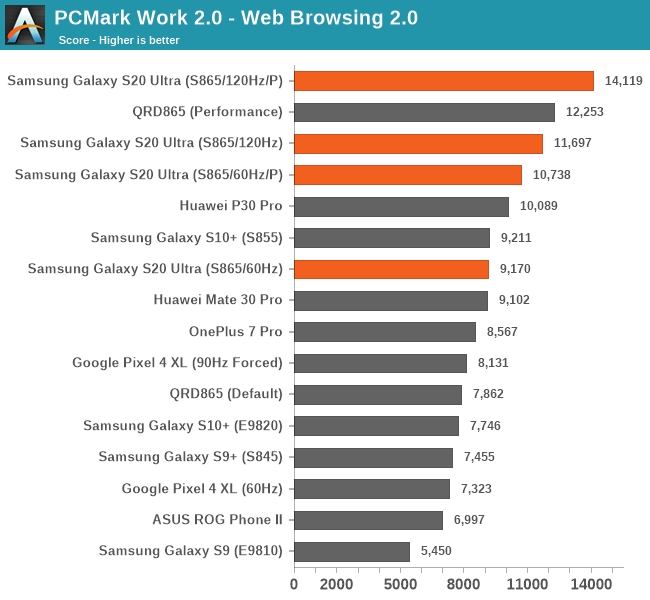
The web browsing test in PCMark is quite sensitive to performance responsiveness, and in this regard, the new Snapdragon 865 doesn’t disappoint. Switching between the 60 and 120Hz modes, we see a notable increase in fluidity, and this is picked up by the benchmark.
At the highest performing settings, the new Galaxy S20 Ultra even outperforms the QRD865 platform that we tested back in December. This was quite surprising, as I wasn't expecting commercial devices to ship with as aggressive settings as that phone’s “Performance Mode”, which did seem tad aggressive.
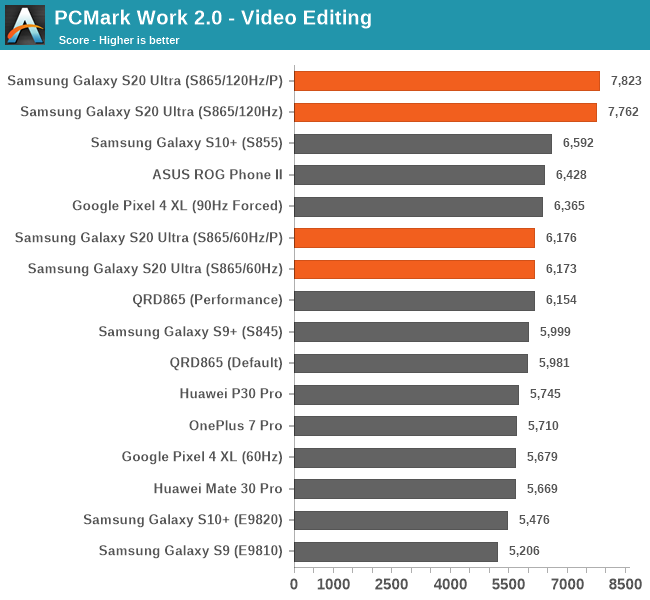
The video editing test has largely lost its performance scaling usefulness, but still is able to pick up the new 120Hz mode of the S20U, representing a jump ahead of any other phone in the market.
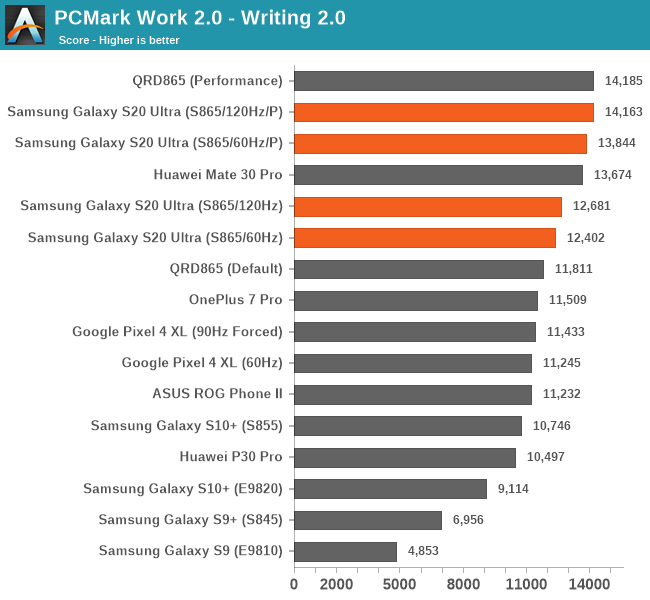
The writing sub-test is very important in terms of being a representation of every-day snappiness of a phone, and the Galaxy S20 Ultra here tops the charts, falling in line with the best scores from the QRD865 as well as now slightly leaping ahead of Huawei’s Mate 30 Pro.
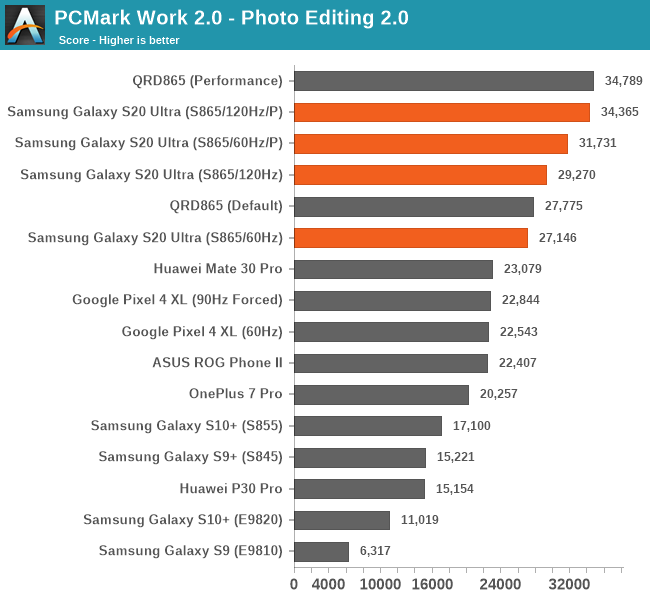
The photo editing test similarly is scaling up in performance across the different setting configurations, showcasing fantastic performance.

The data manipulation score also seemingly is tied to the framerate achieved during the test, and the 120Hz mode of the S20U leads all other devices.
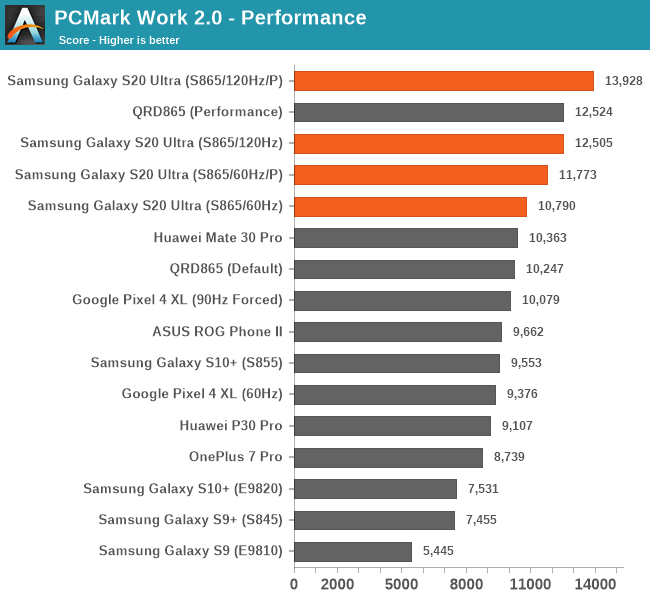
In the overall results, no matter what setting you’re using, the Galaxy S20 Ultra with the Snapdragon 865 tops all other commercially available Android phones out there, and at its peak settings, it even outperforms the QRD865 in its aggressive performance mode.
I did some quick testing of the DVFS aggressiveness between the optimized and performance modes, and was surprised to see no difference in the resulting scaling behavior. This means that the performance differences must arrive from the overall more aggressive scheduling, rather than scaling up to higher frequencies sooner. We’ll go over this aspect in more detail in the full review.
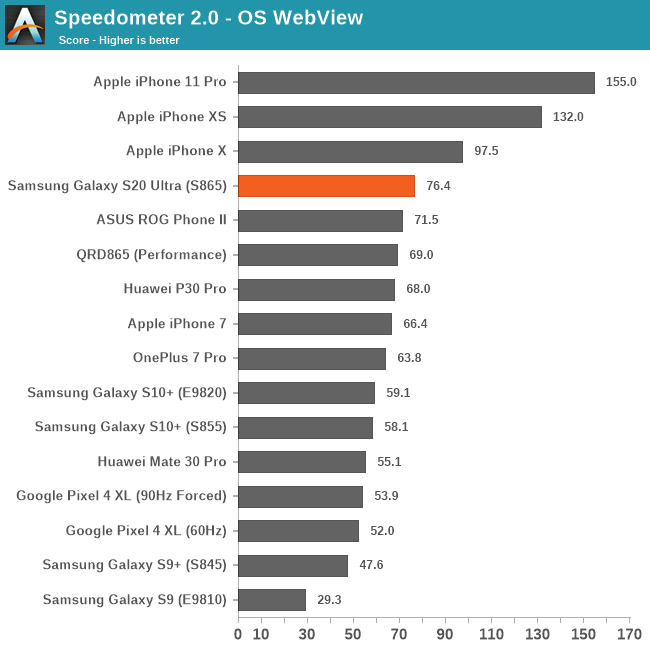
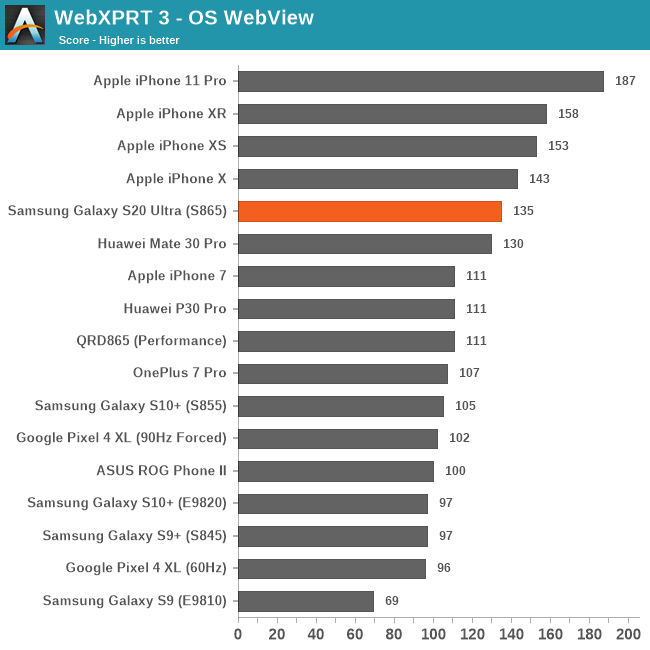
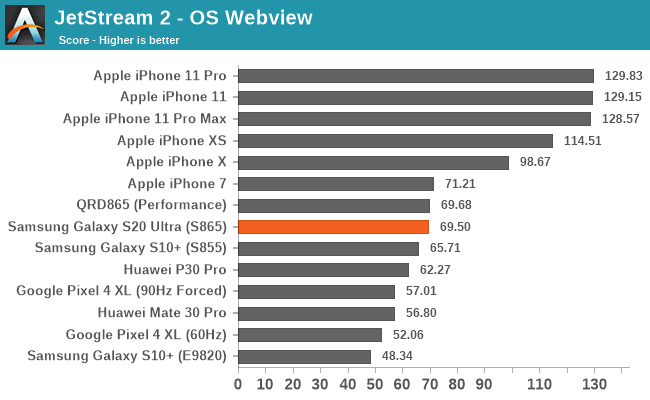
In all our three web tests, we see the S20 Ultra in line with what the QRD865 was able to achieve, with some slight leads in WebXPRT 3. The Cortex-A77 seemingly doesn’t improve its instruction throughput very much in high instruction pressure heavy workloads such as the web-based JS benchmarks, so that’s possibly why we aren’t seeing that large increases here.
CPU Performance & Power
Our power testing back in December on the QRD865 platform wasn't quite as accurate as I would have hoped for, as the phone's power management funcitonality as well PMIC calibration weren’t quite polished. I had opted to publish numbers on the more pessimistic side of the scale, and I’m glad I did as it does turn out that the new chipset performs quite a bit better in actual commercial devices, including of course the S20 Ultra.
These new figures mean that the Snapdragon 865 actually does not behave as expected – we had been anticipating it requiring more power to achieve its higher performance points – and instead Qualcomm has managed to reduce absolute power all while increasing the performance. As a result, we’re seeing a much larger generational improvement in the energy efficiency of the chip. The new “middle” cores of the Snapdragon 865 also outperform the performance cores of the Snapdragon 855, and that does signify for quite a large multi-threaded performance boost.
We’ll be going over the detailed results as well as include an analysis of the Exynos 990 chip in our full review, but for now, it seems that the Snapdragon 865 is an excellent chipset, and will serve as a great base for 2020 devices.


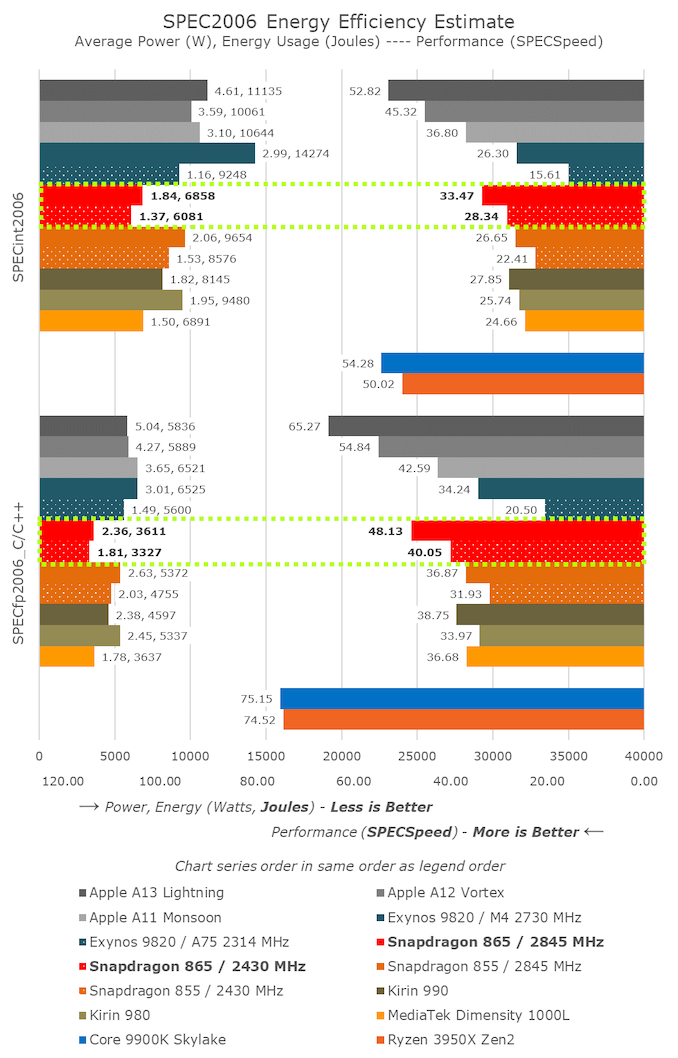








117 Comments
View All Comments
Tigran - Friday, March 13, 2020 - link
As far as I remember Samsung's top Snapdragon smartphones were always worst in GFXBench.Tigran - Friday, March 13, 2020 - link
At least when it's about sustained performance.NICOXIS - Friday, March 13, 2020 - link
I saw the tear down on Jerry Rig Everything youtube channel and I was a bit underwhelmed by the cooling system, maybe that's why sustained speeds are not so great?dianajmclean6 - Monday, March 23, 2020 - link
Six months ago I lost my job and after that I was fortunate enough to stumble upon a great website which literally saved me• I started working for them online and in a short time after I've started averaging 15k a month••• icash68.coMLuckky26 - Tuesday, April 7, 2020 - link
is that why now they've started launching phones with Mediatek chipsets, lolTigran - Friday, March 13, 2020 - link
1) Why iPhone 11 Pro Max's performance in 3DMark Physics is worse than iPhone XS's?2) Do you agree that 3DMark is more RAM bound than GFXBench - and that's why iPhones perform worse than SD-smartphones with much RAM?
Andrei Frumusanu - Friday, March 13, 2020 - link
1) A13 runs hotter, hence more throttling2) No. It's more compute bound, probably some shader combination on which Adreno does better.
Tigran - Friday, March 13, 2020 - link
2) Then why Galaxy Note 9 (6 GB) outperforms Galaxy S9 (4 GB), both E9810?Physics: 2227 vs 1413
Graphics: 3639 vs 2179
https://www.anandtech.com/show/14072/the-samsung-g...
Andrei Frumusanu - Friday, March 13, 2020 - link
Because the Note9 is a big phone and the S9 is a smaller phone. The peak performance of those two units is identical, the sustained performance is determined by thermals and power.Tigran - Friday, March 13, 2020 - link
Agree. Thanks! Just wonder were I've read about 3DMark being RAM bound...